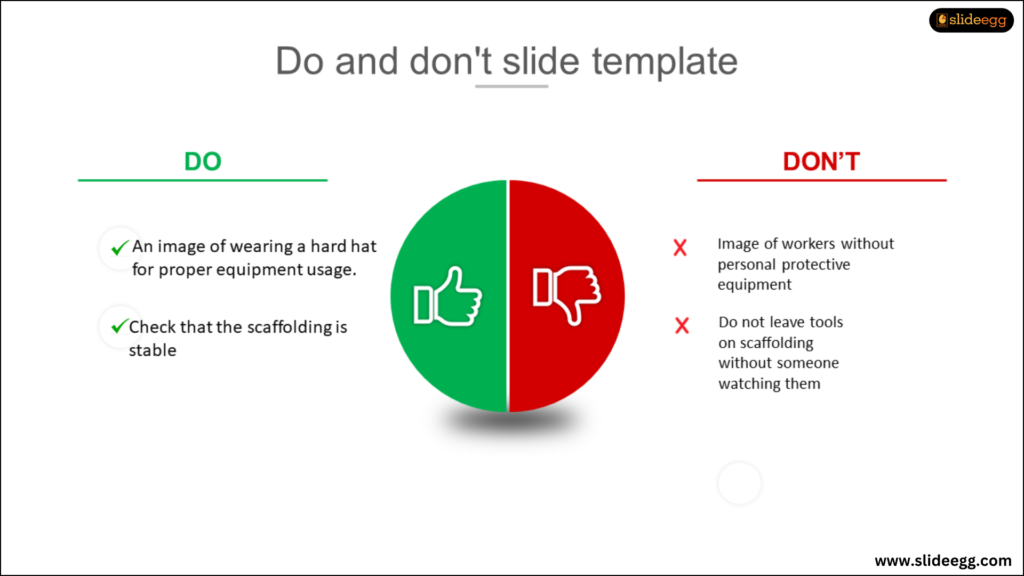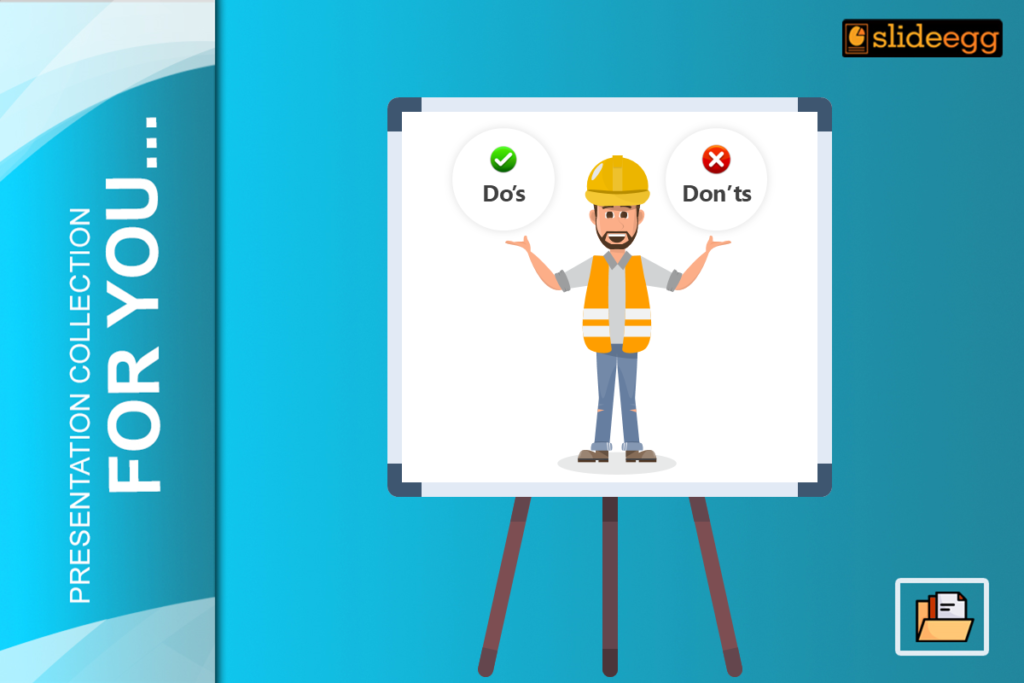Construction sites are filled with potential hazards, from towering cranes to buzzing power tools. The key to keeping everyone safe? Communicating the essential do’s and don’ts in ways that are impossible to ignore.
Use Images in Presentations as Illustrations
Use slides, infographics, or posters as good visual aids to support the do’s and don’ts. A construction PowerPoint template presentation of safe vs. dangerous practices in scaffolding will elaborate on critical points better than words alone.
Example:
Do: An image of wearing a hard hat for proper equipment usage.
Do Not: Graphics of poor practices, such as worker employees without personal protective equipment, should be crossed to identify.
Fact: OSHA reports that lack of vision is the leading cause of workplace injury and death, and it adds to this because visual safety training reduces accidents at the workplace by 20%.
Interactive Training Modules
This method involves interactive learning modules such as quizzes, role-playing, and simulations to reinforce do’s and don’ts. In this way, employees are in a better position to interact with the material and retain that information.
Example:
Create a quiz on safety procedures for handling heavy machinery, emphasising what you should do right and not do. It not only tests knowledge but also reinforces learning through examples.
Stat: Interactive learning retains a rate of 60% more, as compared to any passive technique like reading or listening to lectures.
Create Infographics to Easily Recall
Infographics can be used to easily represent a lot of necessary information. An appropriate do’s and don’ts list can also be provided using visual symbols so that everyone can understand even with the lowest possible language skill.
Example:
An infographic on electrical safety can indicate “Do: Use insulated tools” and “Don’t: Operate electrical equipment with wet hands.”
Stat: Infographics have 30 times more chances of being read than text only. Infographics can be an excellent source of communication of important safety information.
Create Do’s and Don’ts Checklists

Checklist PPT helps to stay in line with the trade’s best practices. They can be used on the job site as reminders that keep teams focused on what it takes for the site to remain safe and efficient.
Checklist Example
Do’s:
Make a checklist of things to inspect on-site. It could include
Check that the scaffolding is stable
Ensure all workers are wearing their helmets.
Don’ts:
Avoid writing vague terms, but use specific words. For example,
Do not leave tools on scaffolding without someone watching them.
Stat: A Construction Industry Institute study found that lists can improve project results by up to 15 per cent.
Include Posters and Signs on the Job Site
Posters and signs are reminders placed throughout the job site as to what to and not to do. They must use simple, plain language, large fonts, and relevant icons that command attention.
Do’s: Use colourful pictures and a colourful title for “Safety Equipment Required” signs that label areas required to have PPE.
Don’t: Avoid signs cluttered with too much writing; rather, use simple words and phrases that will be actionable.
Stat: Safety signs have been shown to reduce incidents by 30% if implemented correctly in the workplace.
Conduct Regular Safety Meetings
Regular safety meetings or toolbox talks are essential for the promotion of do’s and don’ts in a construction site. Some may include new rules, and reviews of recent incidents, and employees may air their questions and seek clarification on some matters.
Do not make the same fatal mistakes repeatedly and discuss the avoidance of the same.
Do not have to hold prolonged periods where the workers sit; make the meeting short as well as relevant to the point.
Stat: Companies that hold weekly safety meetings experience 50% fewer accidents than those holding meetings less often.
On-Site Instructions Using Construction PPT
Mobile apps can also provide on-the-spot instructions to employees, sending “do’s and don’ts” directly to workers’ cell phones or tablets. The apps can include video demonstrations, step-by-step procedures, and safety checklists.
Example:
Do: Download apps that give you real-time updates and alerts about procedures for safety or a new set of guidelines.
Do not: Avoid applications that have troublesome navigation; ease of access makes all the difference for on-site deployment.
Stat: Mobile-based safety apps will reduce training costs by as much as 25% and improve compliance.
Conclusion
The dos and don’ts of construction constitute an essential element for ensuring a secure and smooth workplace. In extremely clear, engaging, and accessible ways, such as through visual presentation, interactive training, infographics, or mobile applications, companies can certainly succeed in ensuring the effective conveyance of safety rules. Applying a few of these simple yet powerful strategies has ensured that employees are aware of certain situations, and job sites remain safe for everyone.







